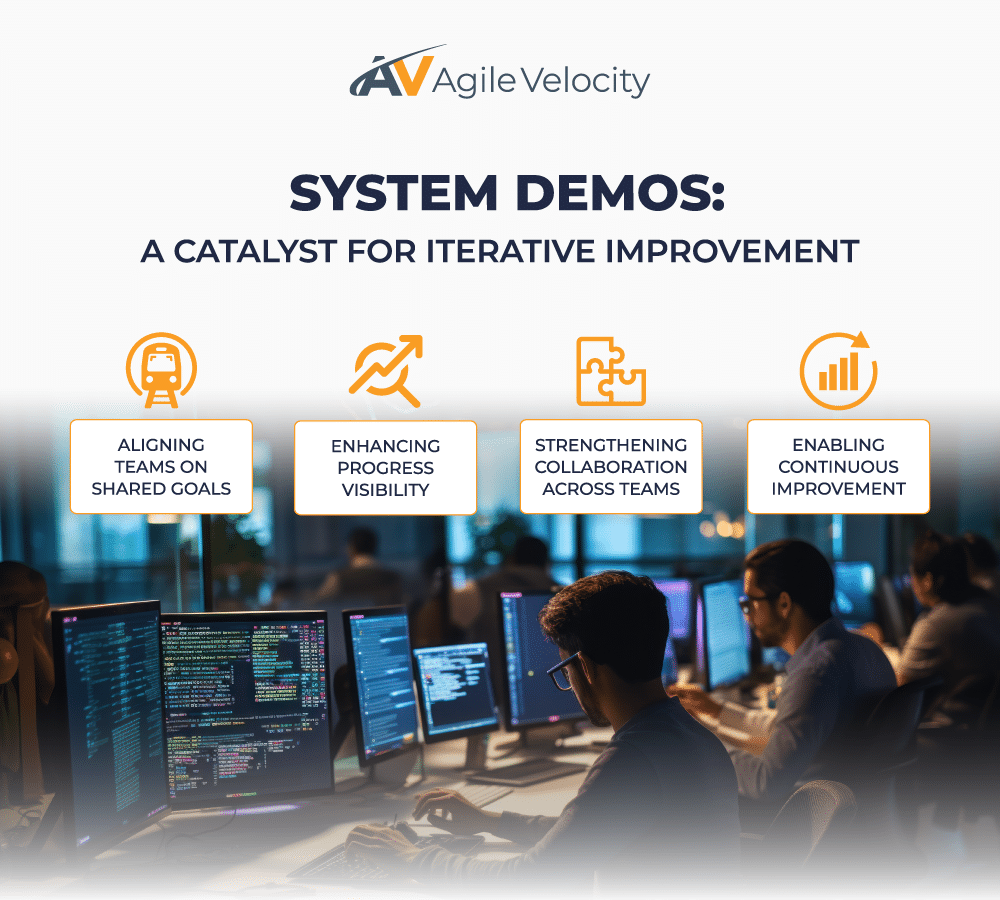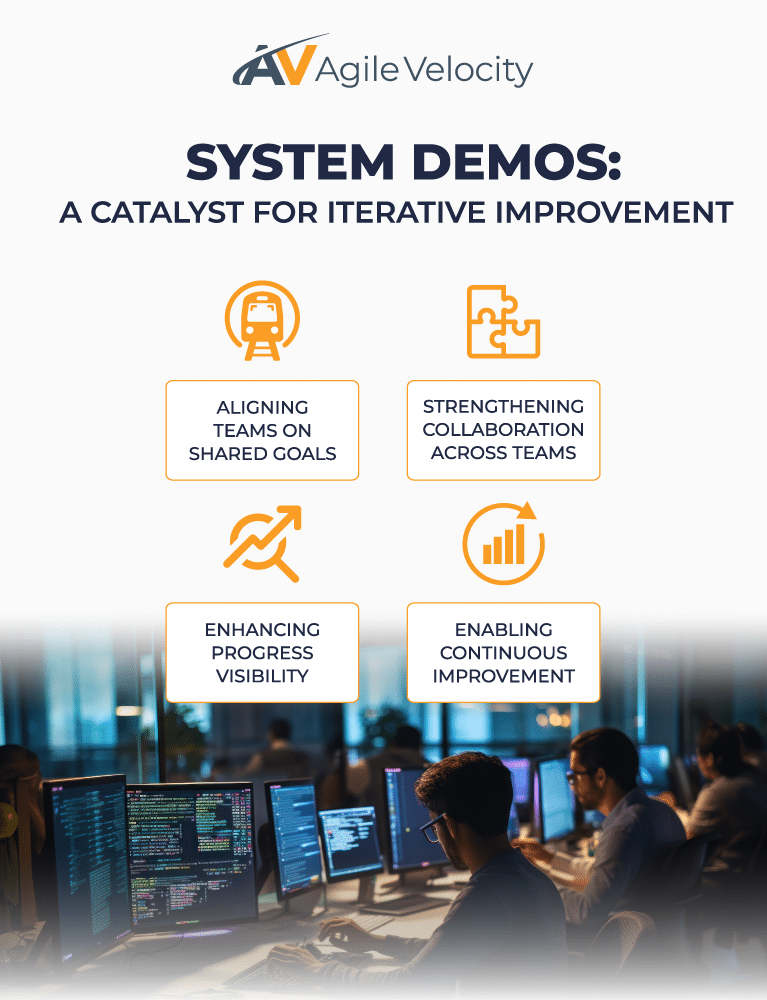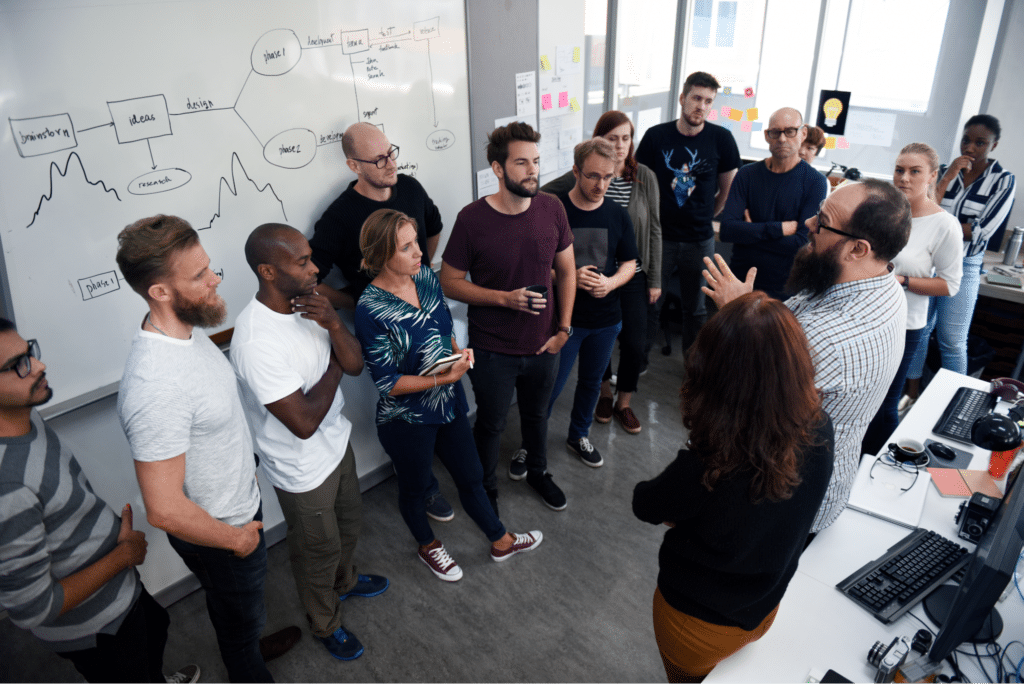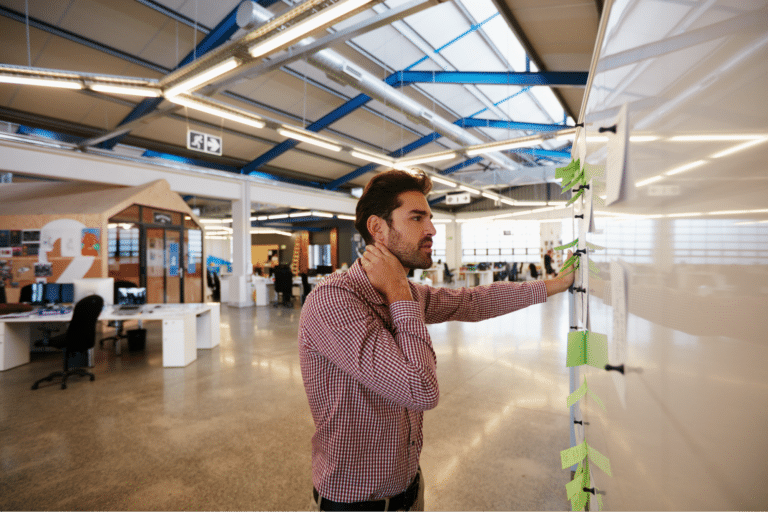In Agile organizations, collaboration, process efficiency, and delivering value at scale are top priorities. For teams utilizing the Scaled Agile Framework® (SAFe®), the Agile Release Train (ART) plays a pivotal role in managing teamwork and aligning toward common goals. Central to this coordination is the System Demo—a recurring event that brings stakeholders and teams together to review progress, gather feedback, and drive alignment.
System Demos are more than simple progress updates; they are purpose-driven opportunities to showcase integrated work from every Agile Team within the ART. By regularly demonstrating working features, these sessions help expose gaps, foster collaboration, and refine priorities—all essential components for continuous improvement.
In this article, we’ll explore the value of System Demos in strengthening ART effectiveness and see how invaluable guidance from Agile Coaches can enhance transparency, alignment, and outcomes.
What Are Agile Release Trains in SAFe?
Scaled Agile Framework (SAFe) enables enterprises to align teams, practices, and goals through the adoption of Lean, Agile, and DevOps principles. At the heart of this coordination is the Agile Release Train (ART), a cornerstone of SAFe that synchronizes multiple Agile Teams under a unified mission: to deliver value incrementally and predictably, at scale.
An ART is not just a team of teams; it’s a structured unit geared toward tackling larger, complex solutions. Each train operates on a shared cadence, planning and executing work in synchronized Iterations that connect the organization’s efforts to business objectives. These shared goals, known as Planning Interval (PI) Objectives, help teams focus on what matters most while increasing collaboration. Because transparency and alignment are so crucial, System Demos become indispensable checkpoints, allowing stakeholders to see actual progress and identify adjustments to keep the train on track.
Learn About the SAFe® Framework
Understanding System Demos in the Scaled Agile Framework
A System Demo is a recurring session in SAFe where progress from all Agile Teams within an ART is showcased as a cohesive whole. Rather than featuring isolated team outputs, a System Demo provides a comprehensive view of the integrated product, reflecting the collective efforts of every team under that train. By presenting a working system at the end of each Iteration, it ensures alignment among stakeholders and drives the ART toward achieving business value.
Key stakeholders in System Demos include:
- Release Train Engineer (RTE): Facilitates the System Demo
- Business Owners (BOs): Provide strategic insights and confirm alignment with organizational priorities.
- Product Owners/Product Management: Represent customer needs, ensuring features meet user expectations.
- Agile Teams: Deliver and test the increments that form each demo’s content.
- Other Stakeholders: Contribute specialized knowledge or external perspectives.
By offering a clear snapshot of integrated progress at each Iteration’s end, System Demos make it easier to spot gaps, address risks, and confirm that everyone remains focused on producing value. This regular feedback cycle helps maintain alignment across the ART and reinforces Agile principles at scale.
The Importance of System Demos for Agile Release Trains
System Demos do more than show off working features; they help confirm alignment, foster collaboration, and promote ongoing improvement across the ART. System Demos also act as an important forcing function for integrating the features and various components that make up the end product or solution. Creating a focus and capability of integrating early and often will help expose problems sooner and will serve as a more realistic measure of progress.
These demos serve as a crucial touchpoint for validating the work being done against business goals, ensuring everyone stays focused on the priorities that bring the most value. Additionally, by providing immediate insights into the progress and integration of diverse teams, System Demos highlight any inconsistencies early, allowing rapid adjustments. This proactive approach ensures that the Agile Release Train continuously moves efficiently toward its objectives, adapting as necessary to meet the demands of evolving business landscapes.
Aligning Teams on Shared Goals
In large-scale initiatives, it’s easy for individual teams to lose sight of the bigger picture. System Demos refocus everyone on shared Planning Interval (PI) Objectives. By showcasing how each piece fits into a unified solution, these events clarify progress and expose any misalignment before it grows into a larger issue.
Enhancing Progress Visibility
Transparency is essential in Agile, and System Demos embody this principle. Showing a tangible, integrated increment of work lets stakeholders quickly recognize if priorities need to shift or if certain aspects need more attention. This clarity helps teams adapt and pivot while avoiding costly rework.
Strengthening Collaboration Across Teams
Multiple teams often contribute to the same solution. System Demos serve as a touchpoint for clarifying dependencies, refining priorities, and resolving issues that emerge. Ultimately, this consistent communication brings teams closer together and helps the ART deliver value more effectively.
Enabling Continuous Improvement
By regularly demonstrating and reviewing completed work, System Demos invite feedback that encourages incremental enhancements. Over time, this process leads to increasingly effective solutions and a culture that continually examines how to deliver better outcomes. Furthermore, these feedback loops ensure that any issues are identified and addressed swiftly, helping teams to stay adaptable and responsive to change. By embedding continuous improvement into the rhythm of the ART, System Demos drive sustainable growth and innovation within Agile organizations.
How System Demos Generate Feedback to Drive Iterative Adjustments
Continuous feedback is the bedrock of Agile, and System Demos are designed to maximize this opportunity. By presenting work that reflects the ART’s integrated product, each demo brings stakeholders together to evaluate whether the product meets current expectations.


Embracing Feedback Loops for Agility
Frequent, iterative cycles ensure issues are identified and addressed quickly. System Demos surface misalignments or potential risks immediately, allowing teams to course-correct before sinking resources into less impactful solutions.
Stakeholders as Co-Creators
System Demos invite constructive input from Business Owners, Product Owners, Product Management, and others who can shape the product in meaningful ways. These voices enrich the solution, ensuring that each Iteration moves the ART closer to delivering business value. Some organizations will even benefit from bringing key customers in to participate in System Demos, gaining valuable insights and feedback.
Real-Time Adjustments for Better Outcomes
When a gap surfaces during a System Demo, it can be corrected in the following Iteration with minimal disruption. This immediate, data-driven approach to improvements helps the ART keep pace with evolving priorities or business goals. This also forces the overall system to health and integrity to be maintained, encourages automation and keeps value flowing.
Building a Culture of Collaboration
By establishing a routine for integrative feedback, System Demos normalize open communication. Teams and stakeholders gain a shared understanding of what needs to happen next, maintaining momentum and focus on value delivery.
Tools to Enhance System Demos and Optimize ART Performance
While System Demos bring clarity to progress and alignment within the ART, the right tools can make these events even more powerful. One such solution is Path to Agility® Navigator, which helps organizations visualize what needs to change, track progress, and define next steps to maintain agility at scale.
Enhancing Visibility with Path to Agility Navigator
Path to Agility Navigator brings structure and clarity to Agile Transformations. By mapping out key milestones, it assists leaders and teams in understanding how System Demos fit into the larger context of their goals. For System Demos, Path to Agility Navigator helps present progress clearly and situate it within the broader objectives of the transformation.
Turning Data into Actionable Insights
System Demos often spark discussions on how to address necessary improvements. Path to Agility Navigator captures relevant data so teams can identify any root causes behind delays or issues. This evidence-based insight aids the ART in making adjustments that directly support delivering high-impact outcomes.
Scaling Iterative Improvement with Technology
By combining System Demos with a robust tool like Path to Agility Navigator, short-term fixes discovered in demos can align with the broader vision of the transformation. This integrated approach keeps agility front and center, even as systems evolve in complexity.
Request a Demo
Best Practices for Conducting Effective System Demos
Conducting effective System Demos requires meticulous planning and execution to ensure that stakeholders gain valuable insights and teams achieve better alignment. To maximize impact, it’s vital to structure the demos so that they highlight critical progress and showcase a cohesive working product. Engaging key stakeholders and facilitating open communication throughout the demo are essential practices that bridge the gap between development efforts and business goals.
Prepare and Integrate Thoroughly
Ensure the completed work is fully integrated and ready to demonstrate. A System Demo should showcase how features operate together in a working system, offering a realistic view of progress to stakeholders.
Highlight PI Objectives to Provide Context
Reinforce how the demonstrated increments tie to Planning Interval (PI) Objectives. This framing clarifies the importance of each feature and how it contributes to overall ART commitments.
Foster Active Participation and Engagement
Encourage an open forum for questions and feedback. Rather than a one-way presentation, System Demos work best when participants—from Business Owners to Agile Teams—feel comfortable voicing their insights and suggestions.
Establish a Feedback-Positive Culture
Promote a welcoming environment where feedback is viewed as a catalyst for improvement. When teams trust that feedback is constructive, they’re more likely to refine their work in ways that increase the product’s value.
Continuously Improve the Demo Process
System Demos themselves can benefit from ongoing adjustments. Evaluate their length, format, and frequency to ensure each session remains engaging, relevant, and effective for the ART.
Challenges in System Demos and How to Overcome Them
Even well-planned System Demos can face hurdles. Recognizing these obstacles and devising strategies to address them keeps demos productive:
Ensuring Stakeholder Engagement
Busy schedules can prevent key stakeholders from participating. Emphasize the value of their involvement—reminding them their feedback directly shapes better outcomes—and schedule demos at times that secure their attendance.
Managing Technical Integration Complexities
Combining multiple teams’ deliverables can lead to last-minute integration challenges. Prioritize integration activities early in each Iteration and allow enough time to test the unified work. Processes such as consistent configuration management also smooth integration.
Fostering Open Communication
Teams may be hesitant to share problems in a broader forum. Facilitators, such as Scrum Masters, should create a supportive setting that treats feedback as a pathway to solutions.
Providing Consistent, Actionable Feedback
Vague critiques offer limited direction. Clarify the feedback focus—whether it’s about usability or functionality—so suggestions remain actionable and align with the ART’s objectives.
The challenges faced during System Demos highlight the importance of careful planning and effective communication. By continually reevaluating and refining these sessions, organizations can overcome these obstacles and ensure that each demo contributes to the ART’s overall success. Moving forward, attention must also be given to evaluating the benefits and outcomes of System Demos, ensuring they deliver maximum value and align closely with strategic business goals.
Avoid Unnecessary Setbacks
How Expert Agile Coach Guidance Can Revolutionize Your System Demos
Guidance from experienced Agile Coaches can be transformative in optimizing System Demos, particularly for organizations aiming to enhance their Agile Release Trains (ART). By imparting their expertise and knowledge, Agile Coaches facilitate smoother operations, improved stakeholder engagement, and the continuous improvement of demo processes. Here’s how they can offer invaluable assistance:
Crafting a Strategic Demo Vision
- Aligning with Organizational Goals: Agile Coaches help ensure System Demos align with the broader strategic objectives, reinforcing their importance as a reflection of business value.
- Customizing Demo Strategies: Coaches tailor demo activities to fit the unique needs of the ART, ensuring each session adds meaningful insights and progressing toward specified goals.
Enhancing Stakeholder Engagement
- Facilitating Communication: Agile Coaches use their expertise to foster an environment where all participants feel confident sharing input, overcoming barriers to open communication.
- Ensuring Value Recognition: They guide stakeholders to perceive the direct impact of their feedback on the product’s evolution, increasing attendance and active participation.
Promoting Excellence in Execution
- Structuring Effective Sessions: Coaches design effective demo agendas and formats, leading to efficient time use and focus on critical outcomes.
- Training Teams for Success: Through training and support, Agile Coaches equip teams with techniques to showcase their achievements effectively and address feedback constructively.
Driving Continuous Improvement
- Feedback Loop Optimization: Agile Coaches streamline feedback processing, ensuring suggestions are actionable and lead to tangible improvements in subsequent iterations.
- Encouraging Iterative Learning: With Agile Coaches emphasizing a culture of learning, System Demos evolve, adapting to new challenges and opportunities seamlessly.
By integrating the insights and methodologies of Agile Coaches, organizations can substantially refine their System Demos, ensuring they serve as a powerful component in driving success for Agile Release Trains.
Leveraging System Demos for Sustained ART Success

System Demos serve as vital checkpoints for keeping ARTs in sync with ongoing objectives. By providing a clear view of progress and enabling real-time feedback, these recurring sessions ensure everyone remains focused on producing incremental value. Meanwhile, powerful tools like Path to Agility Navigator offer additional visibility and structure, helping teams take informed steps toward greater agility.
At Agile Velocity, we specialize in guiding organizations through effective Agile Transformation. If you’re looking to boost your Agile Release Train’s performance, our experts can help refine your System Demos, strengthen team alignment, and leverage the right tools to deliver measurable success.



